PenInHand: August, 2016
American Indian Fountain Pen / Pencil Combo: Mystery SOLVED!
by Jim Mamoulides, August 14, 2016, Updated August 26, 2022
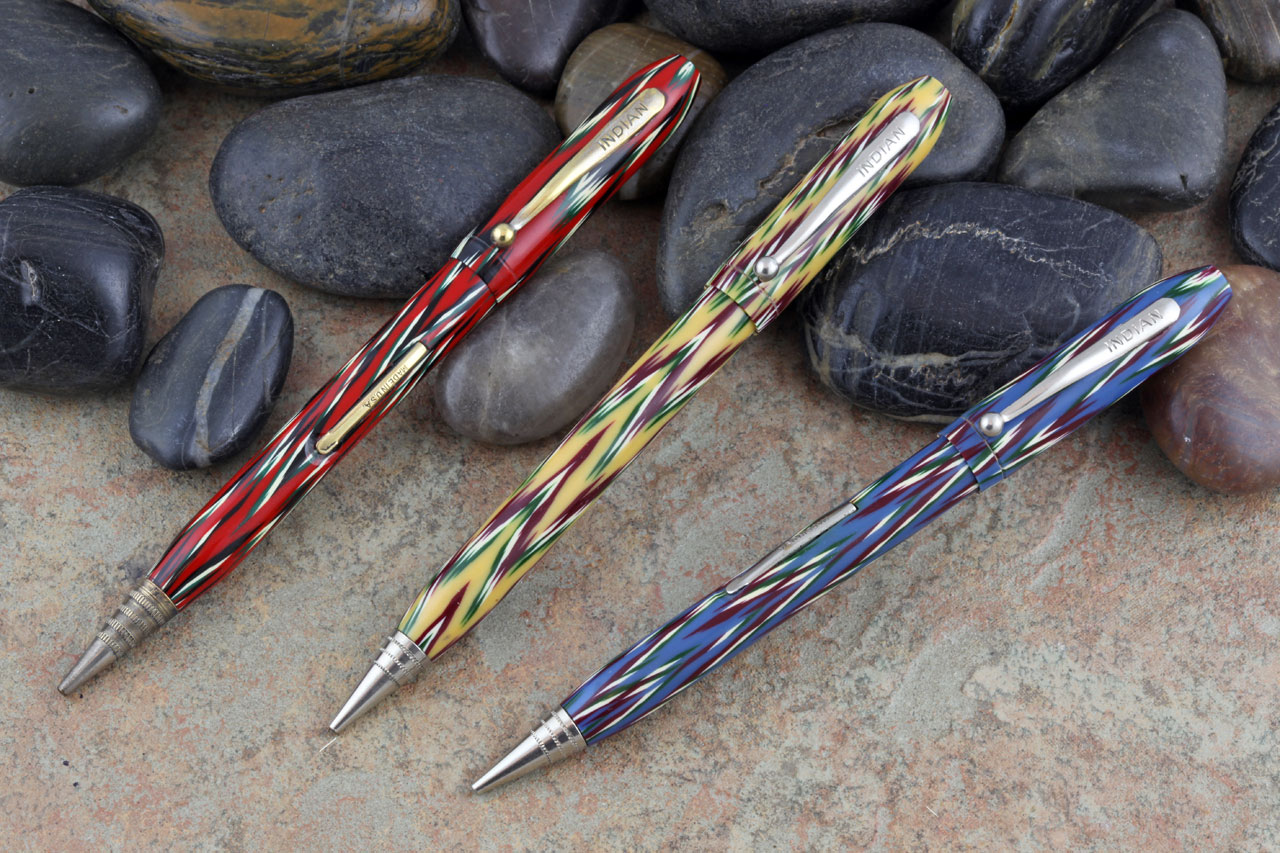 American Indian fountain pen / pencil combos in red, yellow, and blue, closed
American Indian fountain pen / pencil combos in red, yellow, and blue, closed
The American Indian fountain pen / pencil combos are one of the more attractive pens from the 1930s. But what do we know about these pens? When I wrote this article in 2016, there was almost no information about them other than existing examples and best guesses by collectors as to their origin.
So who made them? Unlike many pens from the 1930s, these pens do not carry a barrel imprint, which usually indicated the manufacturer, location, and sometimes a patent number. Several collectors speculate that these were made by Arnold, of Petersburg, Virginia, and given no better information at the time, it sounded reasonable.
Doing some research on a pen holder made by the American Pencil Company led me to some catalogs that solved the mystery. The Hoboken Historical Museum in Hoboken, New Jersey has a 1937 American Pencil Company catalog in their collection, and there on page 33 is the answer: these writing instruments were made by the American Pencil Company. It's clear from the catalog page that they were sold on retail counter cards, so don't go looking for boxes and papers for these pens.
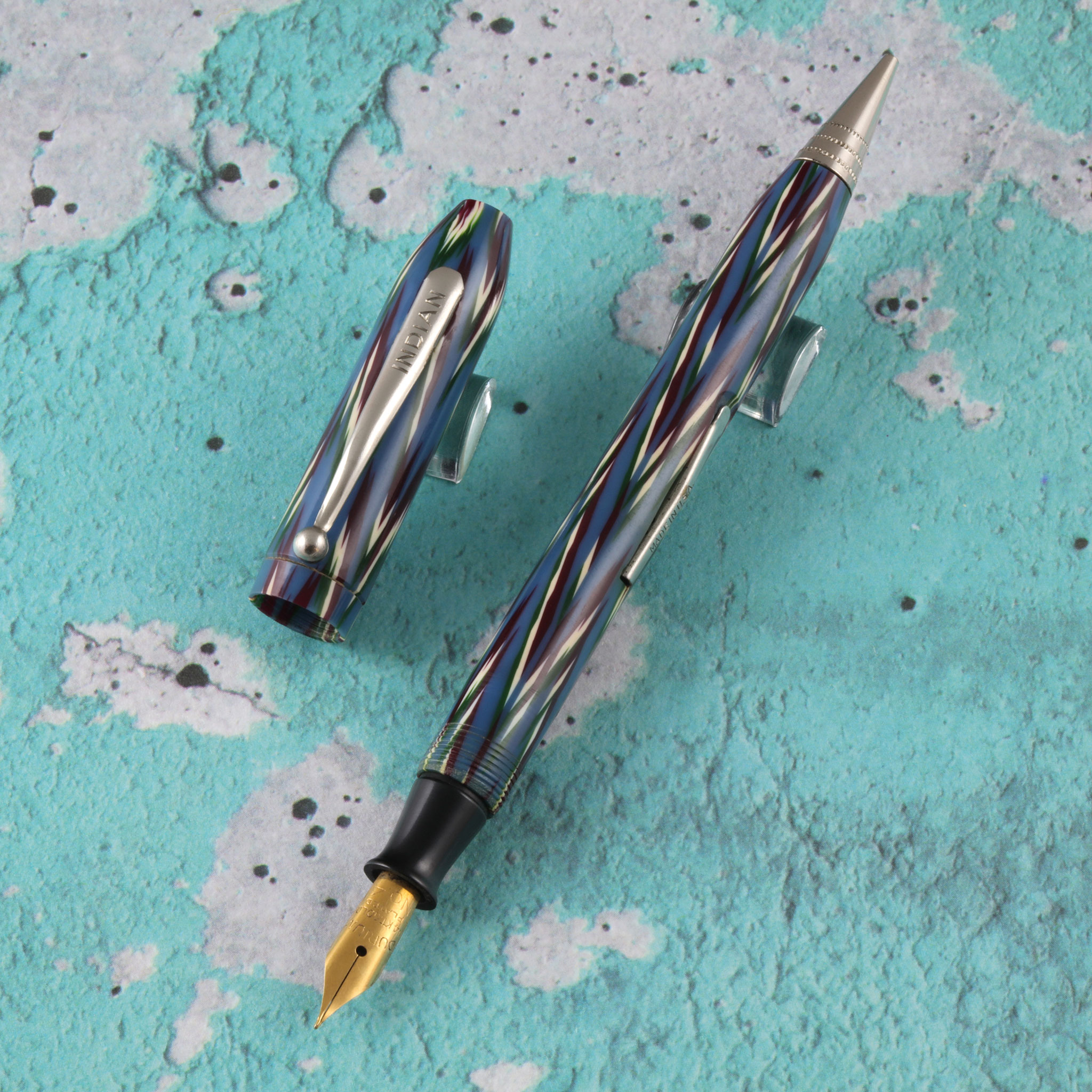 American Indian fountain pen / pencil combo in blue, open
American Indian fountain pen / pencil combo in blue, open
Why Indian? A dazzling reason!
Folklore in pen collecting says these writing instruments were made to be sold on American Indian reservations. This, by the way, is pure speculation. The 1937 catalog page gives no clues, but one would have to assume that the American Pencil Company made these writing instruments for any dealer to carry. Influence could have come from Western stories by authors such as Zane Grey and Western pulp fiction magazines that were very popular in the early 20th century. Clearly from the clip, the name, and the amazing Pyroxylin celluloid, there is an obvious American Indian inspiration, specifically Navajo.
I actually came across this idea from an eBay listing, calling one of these writing instruments a "dazzler." The name was picked deliberately, not because the pen was dazzling, but because it evokes the Navajo Eye Dazzler woven rugs and blankets made in the late 19th century. The history of Navajo woven articles is a much bigger topic than I can treat here, but the key point is the design and color choices of the celluloid clearly are an homage to the designs seen on Navajo Eye Dazzler rugs and blankets.
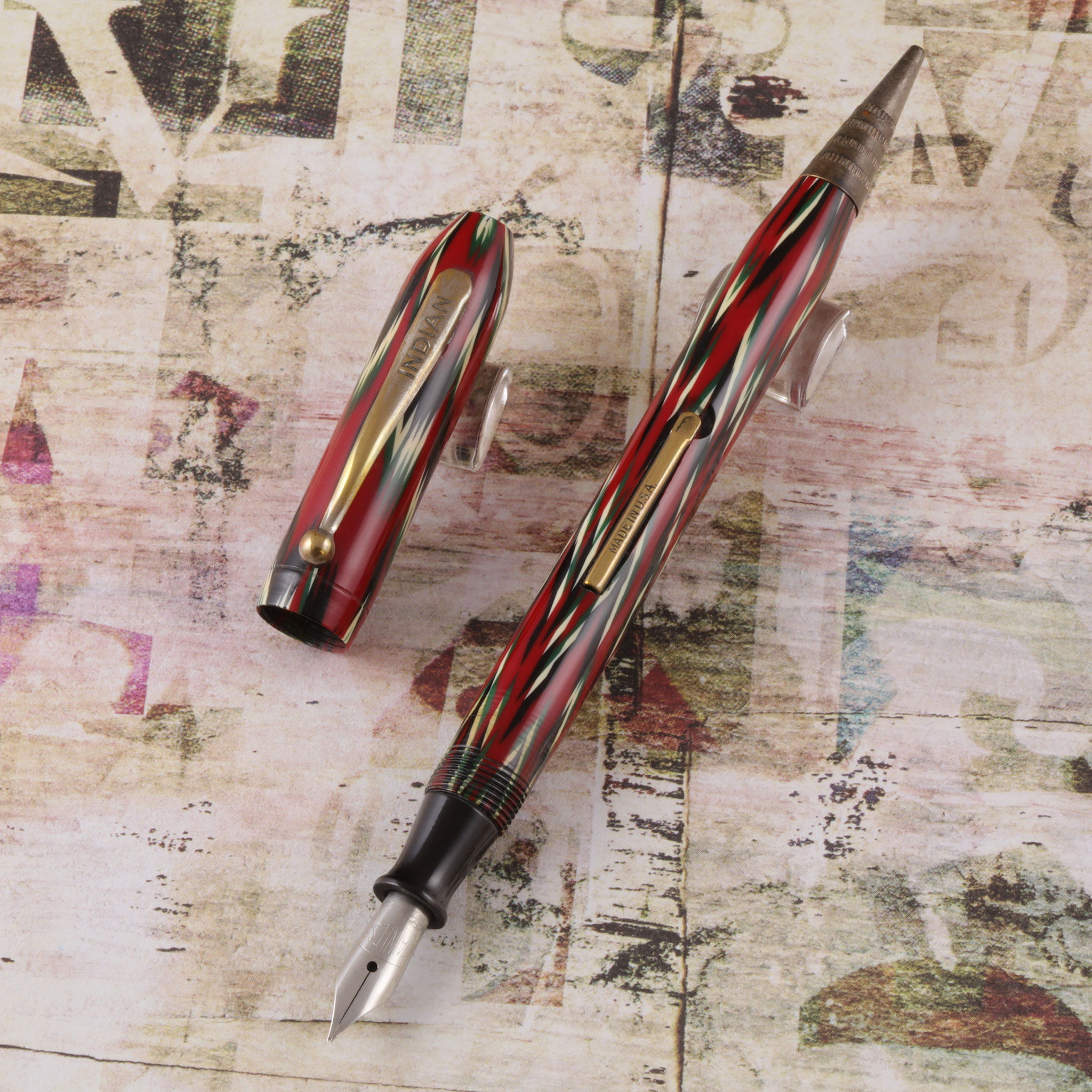 American Indian fountain pen / pencil combo in red, open
American Indian fountain pen / pencil combo in red, open
There are internet stores that specialize in Navajo woven articles, both antique and contemporary. One example from the Nizhoni Ranch Gallery makes the point about the Eye Dazzler connection: you can see it by clicking here.
The consensus of the references I used is that the Eye Dazzler geometric designs were a convergence of borrowing ideas from Mexican serape blankets and weaving them with newly available boldly colored Germantown, Pennsylvania wools, brought in as the railroads came into Navajo country. The designs incorporate diamonds, triangles, chevrons, and Mexican serrate elements, usually throughout the woven piece. Vintage and modern Navajo woven rugs and blankets are highly prized and certain exceptional weavers are known by name to collectors.
An Eye Dazzler gallery:
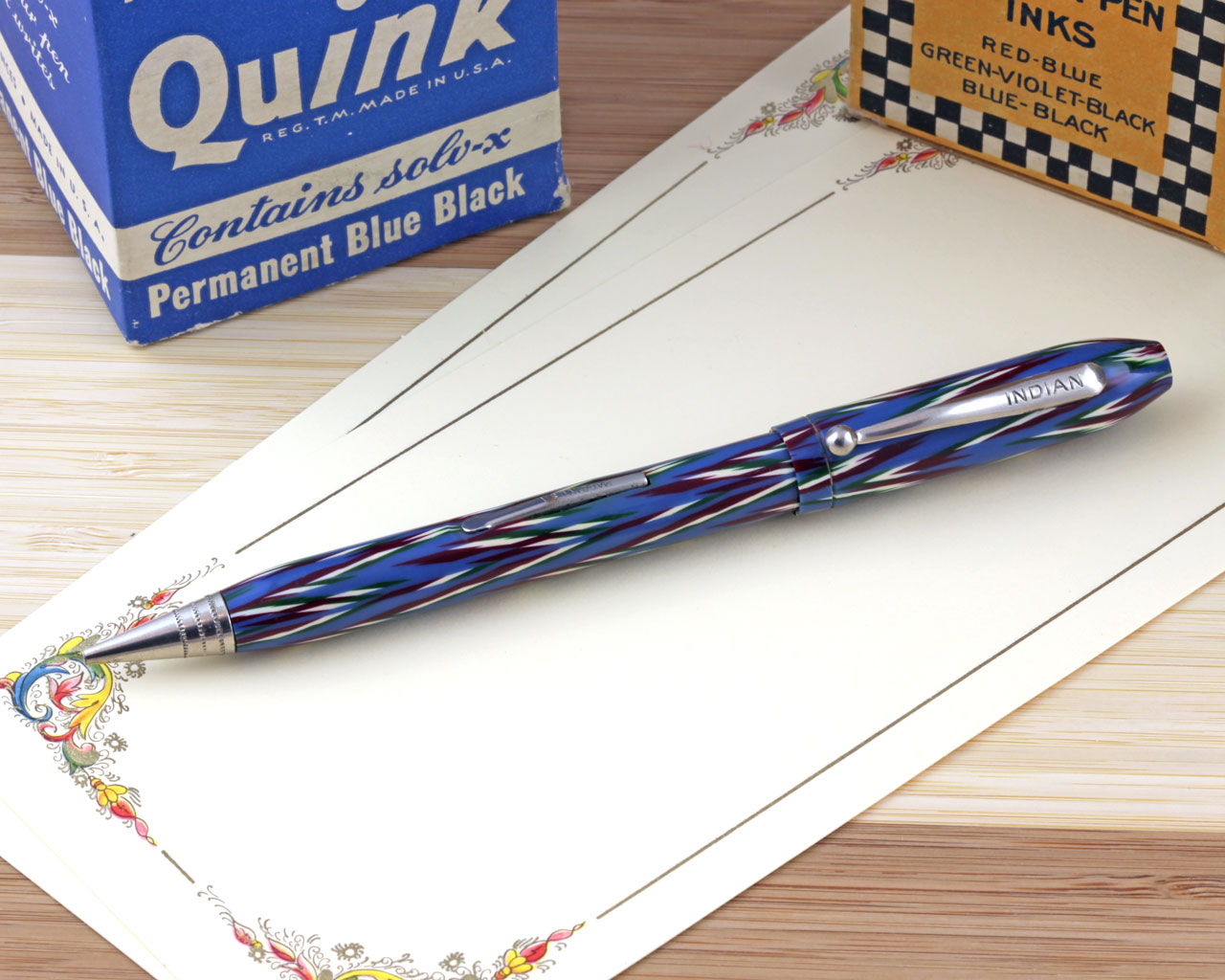 American Indian fountain pen / pencil combo in blue, closed
American Indian fountain pen / pencil combo in blue, closed
The American Indian blue fountain pen / pencil combo is a base blue with green, burgundy and cream accents.
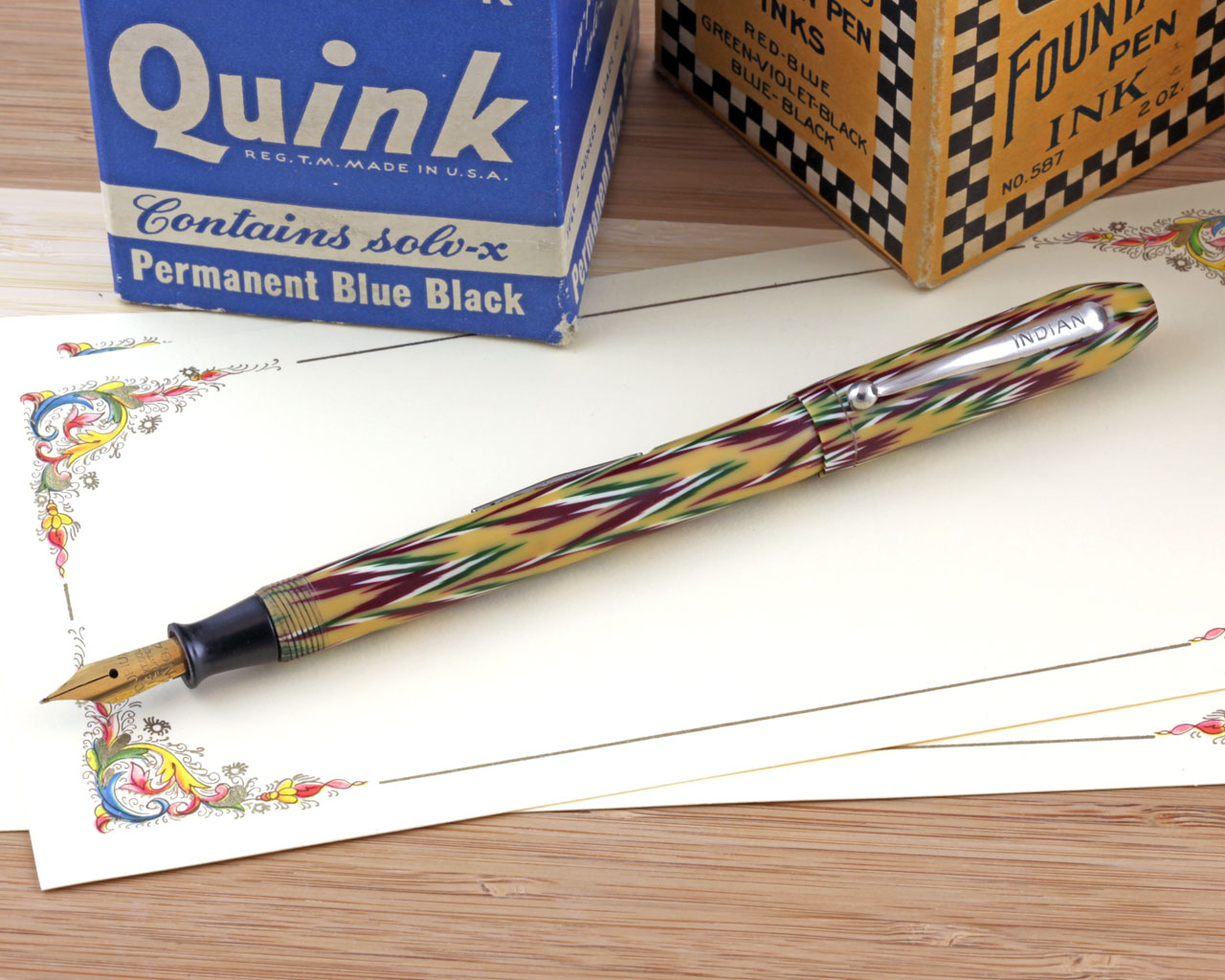 American Indian fountain pen / pencil combo in yellow, posted
American Indian fountain pen / pencil combo in yellow, posted
The American Indian yellow fountain pen / pencil combo is a base mustard yellow with burgundy, green, and cream accents.
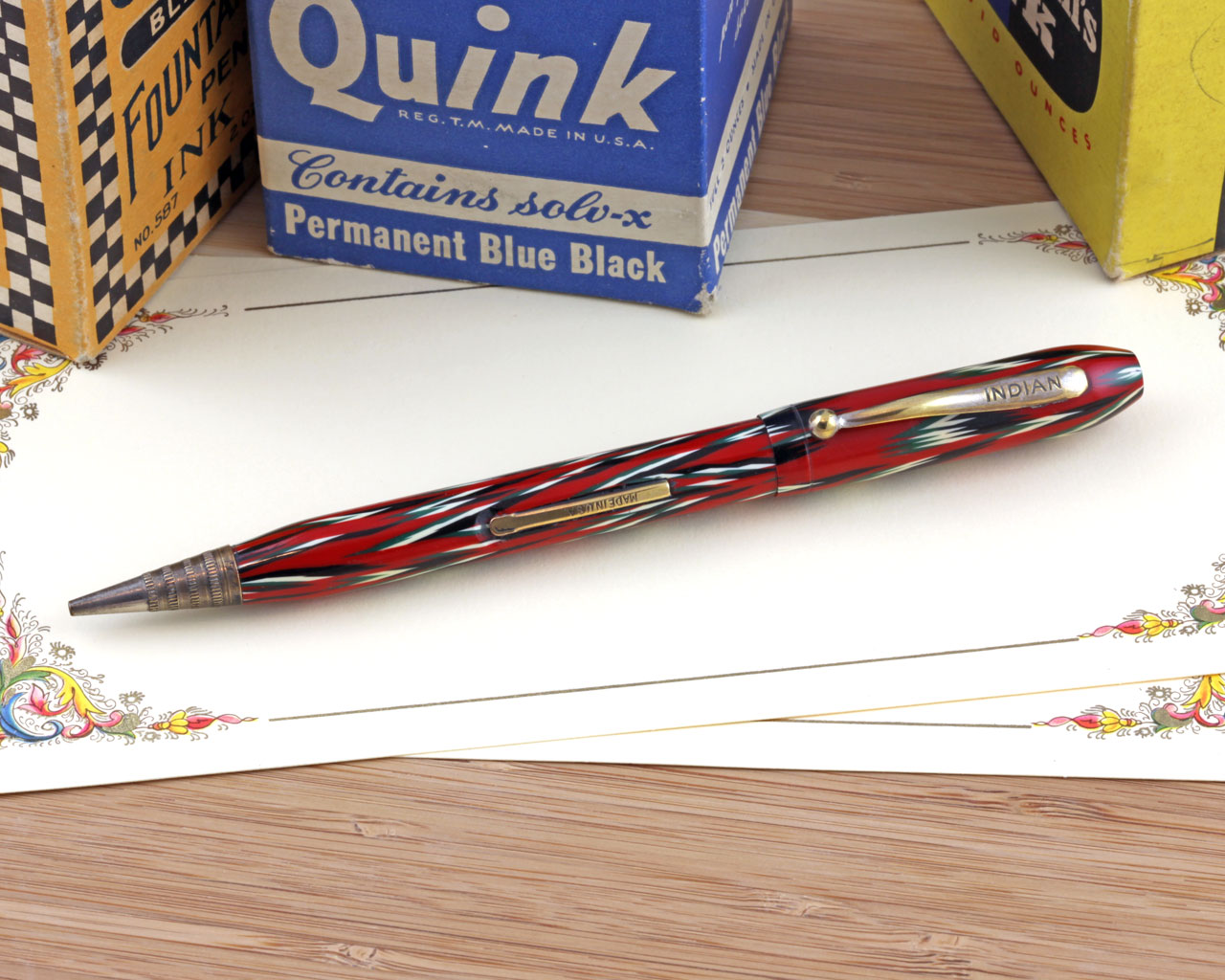 American Indian fountain pen / pencil combo in red, closed
American Indian fountain pen / pencil combo in red, closed
The American Indian red fountain pen / pencil combo is a base deep red with black, green, and cream accents.
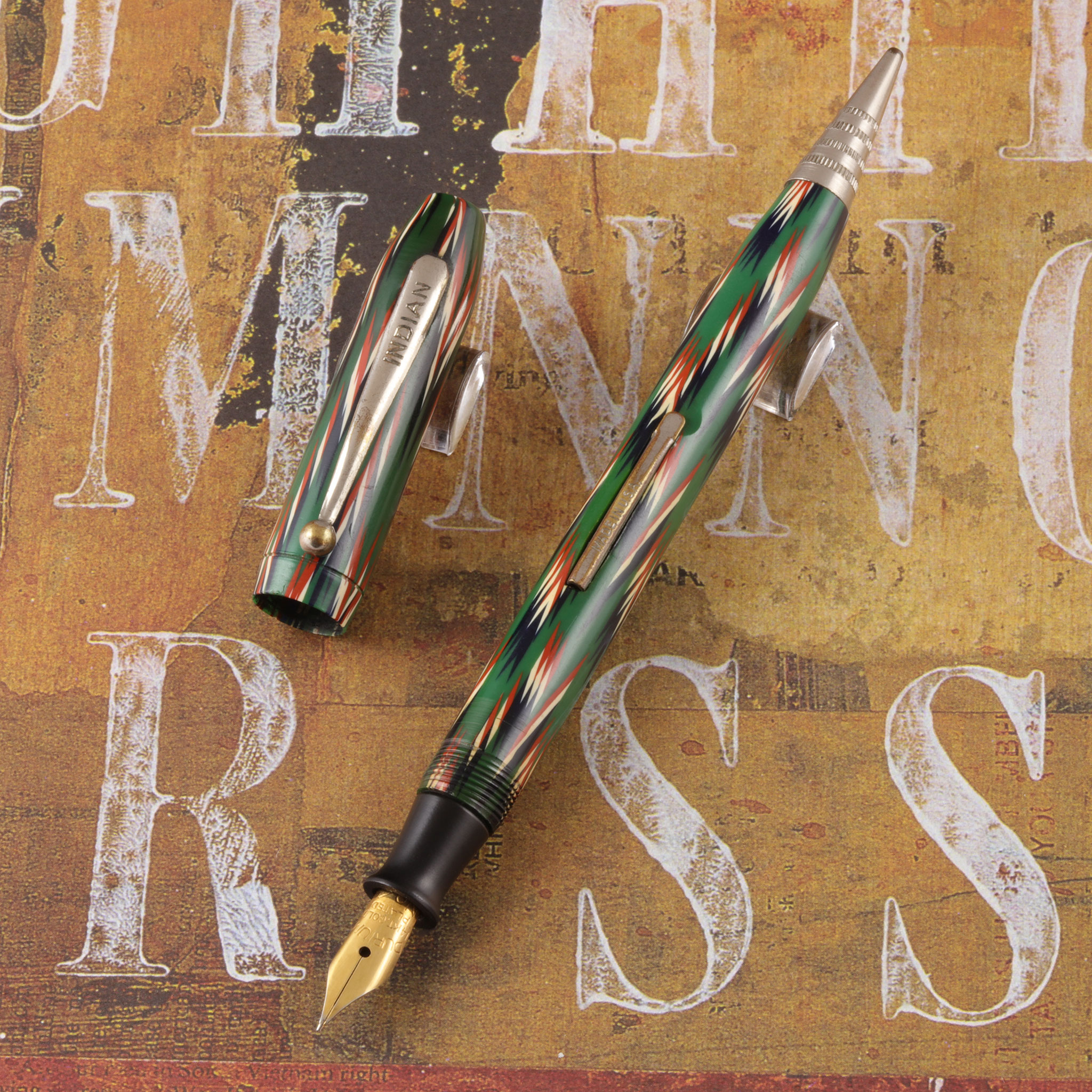 American Indian fountain pen / pencil combo in green, open
American Indian fountain pen / pencil combo in green, open
The American Indian green fountain pen / pencil combo is a base dark green with black, orange, and cream accents.
Were there only the four colors?
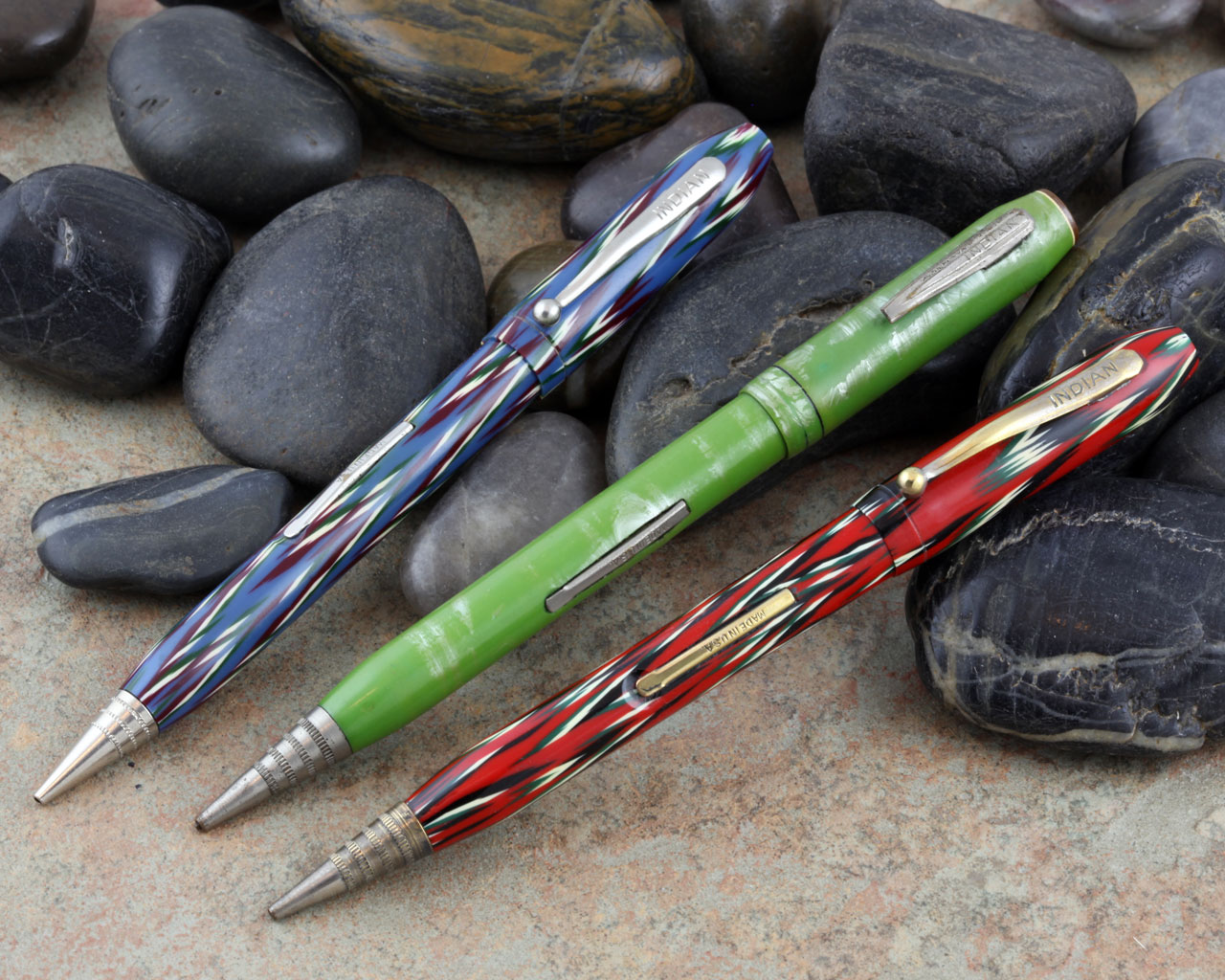 American Indian fountain pen / pencil combos in blue, green, and red, closed
American Indian fountain pen / pencil combos in blue, green, and red, closed
Collectors who know the American Indian fountain pen / pencil combos will certainly be familiar with the four known colors. Four color choices are mentioned in the 1937 catalog page. In researching this article, I certainly thought that was all there was to it: find four nice examples and see if I could discover any primary information on dates, pricing, production.
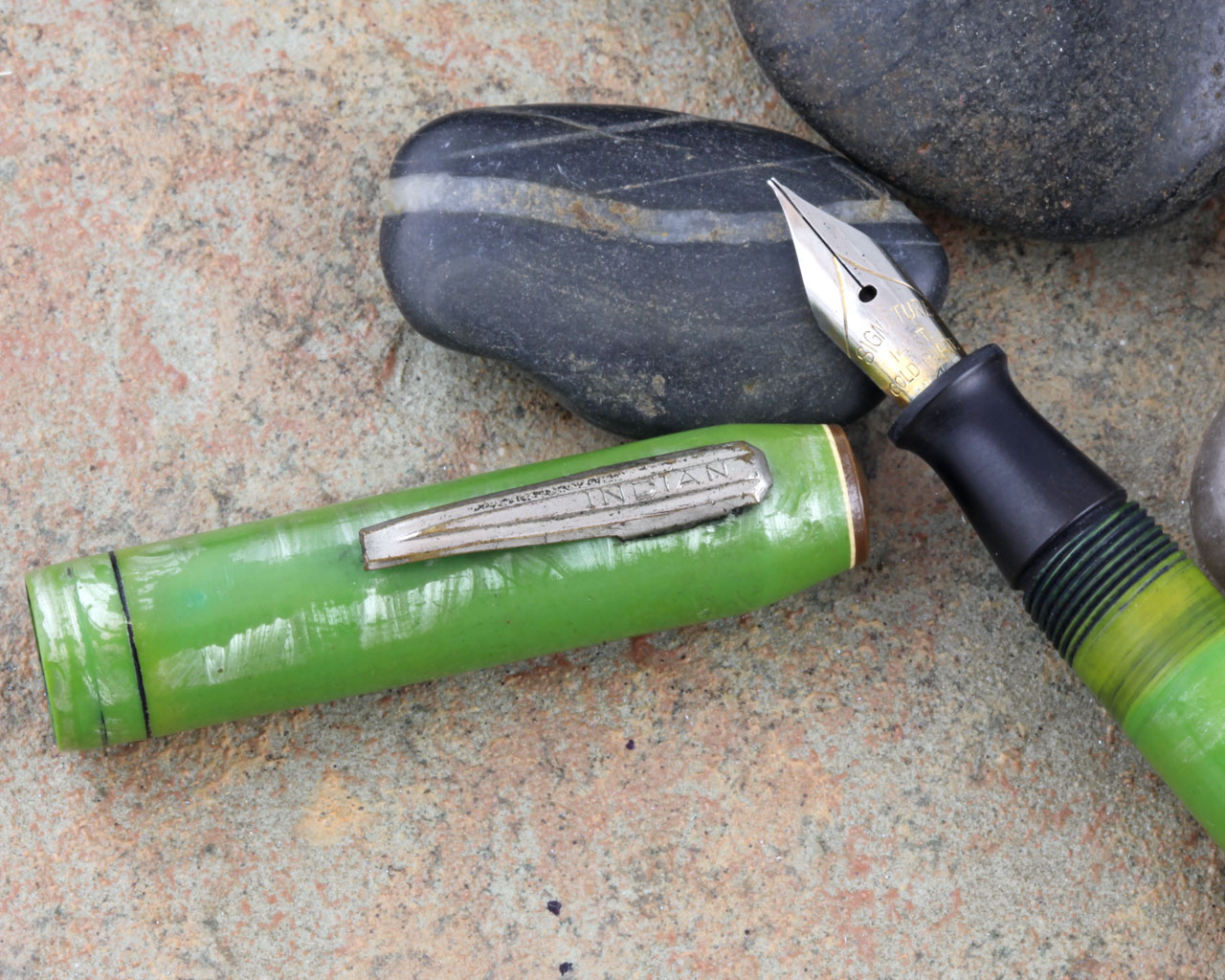 American Indian fountain pen / pencil combo in green, clip and nib detail
American Indian fountain pen / pencil combo in green, clip and nib detail
In seeking nice examples to photograph, I ran across an anomaly: this sage green writing instrument with a silvery paint residue with the "INDIAN" name stamped on the broken clip. The clip certainly looks like the flat ball type clip with the long triangle design used on some of the Indian combos. The cap, barrel and section match with the sample pens and the cap can interchange with them. The pencil unit and the overall pen is the same size as the longer version of the Indian combo.
Unlike other American Indian combos, this one has a cap and barrel in a solid color, in this case a sage green, and appears to have been painted, though it's not clear what the design may have been. The cap top is different, having a brown and cream top piece and two cut and black paint filled rings at the cap lip. To me, this is evidence that there is at least one other Indian fountain pen / pencil combo model or perhaps it's a joke by a pen repair person. I would be very interested in seeing if more examples turn up.
Identification guide and features:
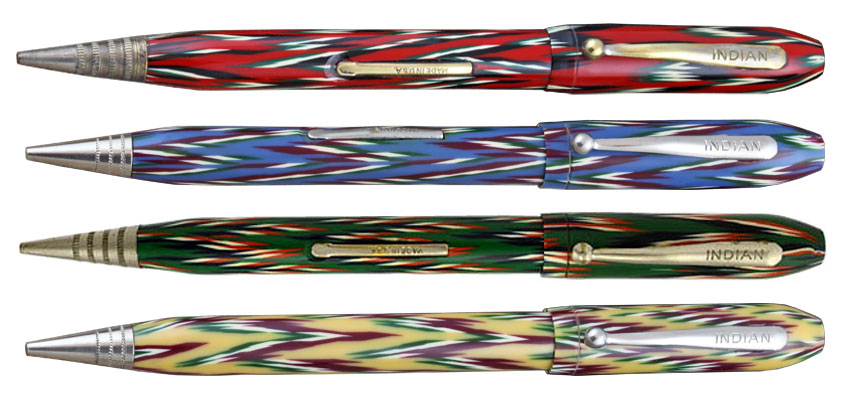 American Indian fountain pen / pencil combos in red, blue, green, and yellow, closed
American Indian fountain pen / pencil combos in red, blue, green, and yellow, closed
Photo of green pen courtesy Teri Morris, Peyton Street Pens
By observation of existing examples, the American Indian fountain pen / pencil combos appear to come in two lengths and with two clip types. The length of the pen appears to be related primarily to the pencil unit installed, as all pens appear to have the same fountain pen front end, cap size and cap threading. The pencil unit is distinguished by either three or four stamped or engraved grip rings, with the unit having four making the combo longer. The writing instruments therefore measure 5 3/8 inches or 5 5/16 inches with the cap on. Clips are either plain faced with a ball end or having an elongated, raised triangle design with a flat ball end. Trim is lightly applied nickel plating over brass, giving pens with plating loss the appearance of gold plating. Retail price in 1937 was 25 cents.
- Multicolored Eye Dazzler patterned plastic resin cap and barrel in red, blue, green or yellow
- Nickel plated trim
- Clip stamped INDIAN, with either a plain faced ball end design or a long raised triangle design with a flat ball end
- Cap has a thin band cut just below the clip
- Cap unscrews
- Gold plated stainless steel nib stamped DURIUM 14KT GOLD PLATED NO. 4
- Lever stamped MADE IN USA
- Unknown nib grades offered, fine and medium observed
- About 5 3/8 inches or 5 5/16 inches long capped, depending on length of pencil unit
- Retail price 25 cents in 1937
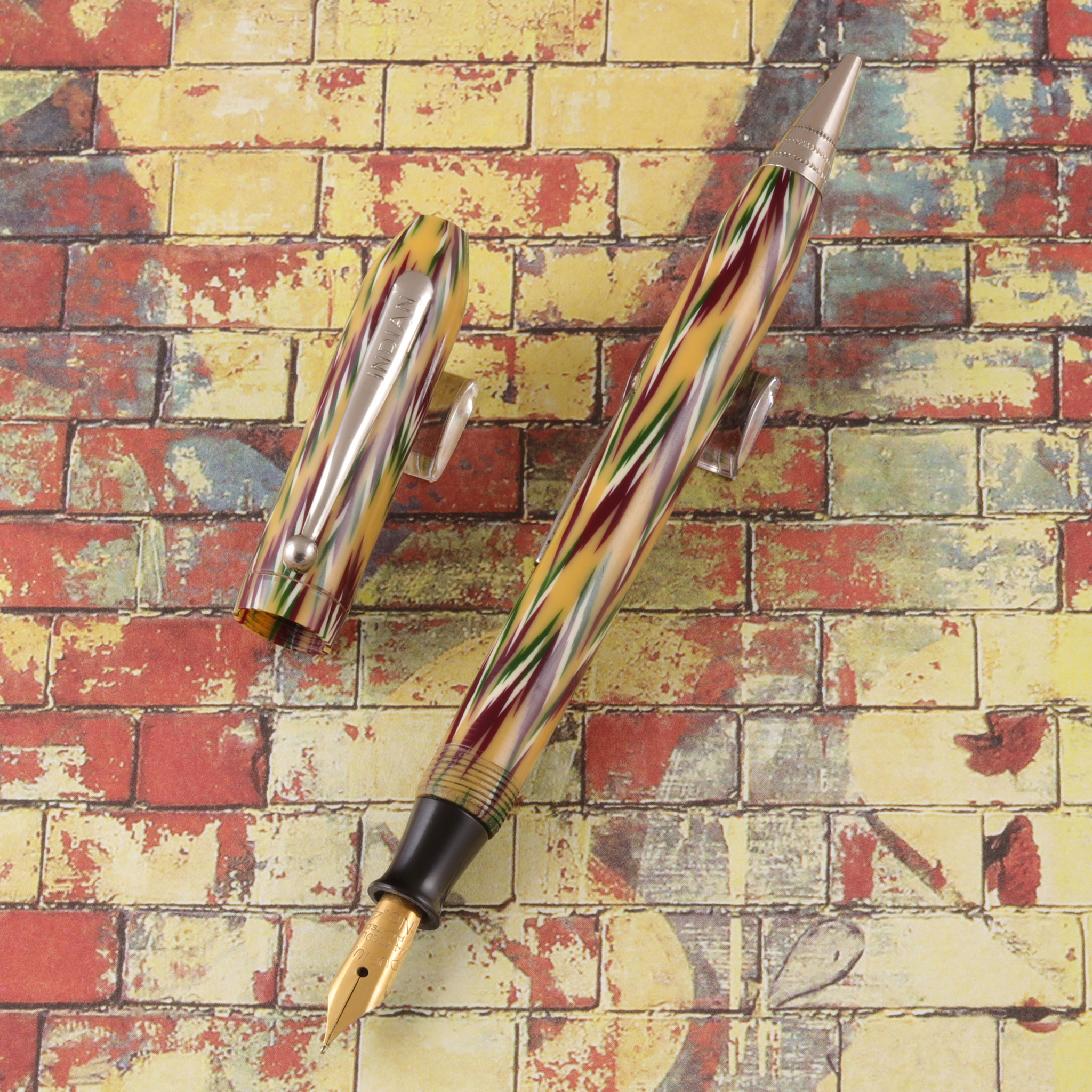 American Indian fountain pen / pencil combo in yellow, open
American Indian fountain pen / pencil combo in yellow, open
Performance:
I have the good fortune to review four of the American Indian fountain pen / pencil combos, all in very good to excellent condition. The cap and barrel material is quite vivid in person and the design hides the seam line in the plastic very well. Unlike many other pens from the 1930s, there is no noticeable discoloration in the cap or barrel on any of them. The plating on the red pen shows typical plating loss from the cheap plating done on lower end pens of the period. It might be amusing to have these re-plated.
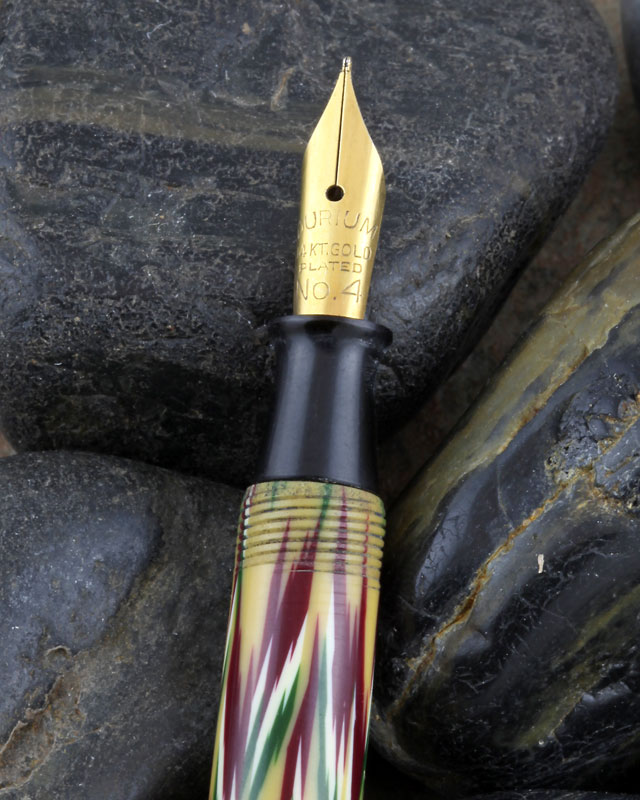 Indian fountain pen / pencil combo in yellow, nib detail
Indian fountain pen / pencil combo in yellow, nib detail
Only one of the pens tested is restored, and it operates as well as any contemporary lever-fill pen. I dip tested the two with original nibs and they are very firm, fairly smooth writers. You will not think of one of these are a daily user pen, based on the nib. The nibs do not appear to have tipping, but have folded over tines. I also tried the out the pencil with one that had a working unit.
In the hand, these are long, light, slender writing instruments. I found they post well, but worked fine with the cap off, both ways. Given the collectible quality of each, the less than impressive writing quality, and the balky pencils, I am not sure I would use any of them as a daily user. I see them more as collection pens.
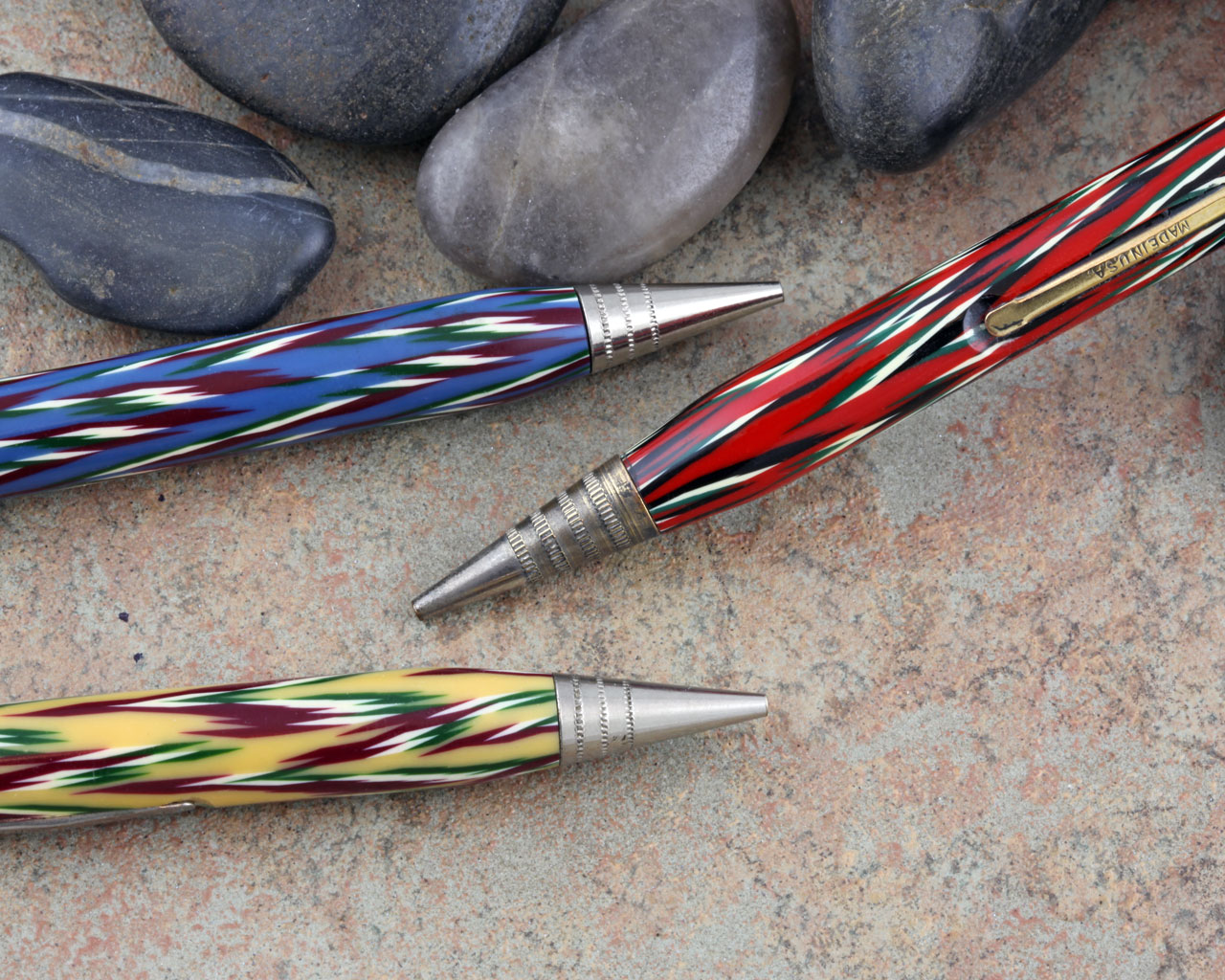 Indian fountain pen / pencil combos in blue, red, and yellow, pencil detail
Indian fountain pen / pencil combos in blue, red, and yellow, pencil detail
American Indian fountain pen / pencil combos have steadily risen in value as collectors have come to appreciate the vivid colors and that they are relatively uncommon. They are easily recognizable and unmistakable, but appear to appeal to only selected collectors. I expect prices to continue to increase as they are better documented and better known.
Acknowledgment
Thanks to Teri Morris of Peyton Street Pens for use of her photos of the green Indian fountain pen / pencil combo.
References
American Pencil Company Catalog, 1937, Hoboken New Jersey, page 33
Eye Dazzlers, Arizona State Museum, © 2006–2015, Arizona Board of Regents
EyeDazzler, Wide Ruins Traders, © 2008 rugtrader.com
Indian Fountain Pen, Phil Munson, March 10, 2011
Indian Fountain Pen Combo / Part II, Phil Munson, October 24, 2011
Nizhoni Ranch Gallery, © 1996 - 2016 Classic & Contemporary Amerind Art Inc.
Interact
Comments on this article may be sent to the author, Jim Mamoulides


